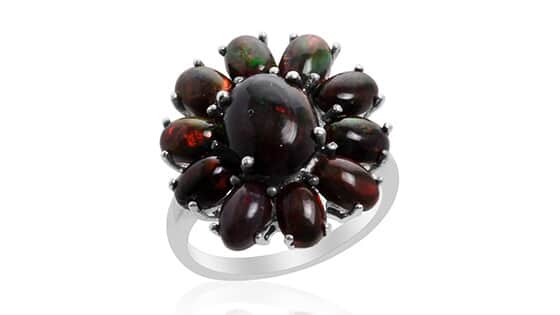Ethiopian Sable / Black Opal Gemstone
The opal is celebrated for its spectacle of rainbow-like hues which vary with lighting or angle of observation. The sable Ethiopian opal is celebrated for its intense color and fiery glow.

The name opal evolved from the Roman word "opalus" which traces its roots from the Greek's "opallios " meaning to see a change of color. This Greek word is likewise a revision of the ancient Indian Sanskrit's "upala " which means precious stone.
The development of this gemstone started millions of years ago when a mixture of silica and water flowed into cracks and holes in the ground. Over time it hardened and solidified to turn into opal. Some opals are hydrophanes meaning that they can soak up water like a sponge. When hydrated the stone typically becomes more translucent and the play of colors more defined. However the sable opal's fire will diminish when wet. But its fire returns once the stone has dried.
The sable Ethiopian opal is an enhanced black opal characterized by its intense colors and high clarity against a black background. The opal is smoked a technique used exclusively on opal. The gem is wrapped in brown paper and charred creating a thin dark brown coating that intensifies the fire or play-of-color. Once the coating wears off the black opal appears a very dark brown to jet-black. This enhancement does not diminish the natural color play of the opal.
• Aboriginal Australians believe that opals came to be when their creator came down to earth on a rainbow to bring the message of peace to mankind. He breathed life into the stones he stepped on and they started sparkling in all the colors of the rainbow.
• Opals are often considered a lucky charm that brings beauty success and happiness to its wearer.
• The ancient Greeks believed that opals brought powers of foresight and prophecy.
• The Romans considering them to be the symbol of hope and purity.
• Ancient Arabs believed that they fell from the heavens in flashes of lightning. Based on this tradition opals were believed to protect against lightning strikes and bad elements.
• Queen Victoria was a fan of opals. Her five daughters and immediate circle received gifts containing this fine gemstone. It became a much coveted piece since the Royal Court of Britain was considered the model for fashion at the time.
• William Shakespeare called the opal the "Queen of Gems" in his comedy Twelfth Night."
GemGPS
Location: Ethiopia
While Ethiopia is one of the oldest inhabited areas on earth and anthropological reports show evidence of opal tools dating back to 4000 BCE. Despite a long history modern mining for Ethiopian opals is a fairly recent development. Ethiopian hydrophane opals were discovered in the Welo region of Ethiopia in 2008. The sable variety of Ethiopian opal has created a lot of excitement in the market because of its beautiful bright and spectacular color play.

- Ranks 6 to 6.5 on Mohs hardness scale.
- Colors present dark brown or black with iridescent rainbow flecks.
- Sourced from the Welo region of Ethiopia.
- Member of the precious opal family.
- Also known as black opal dark opal or smoked opal.
- Birthstone for October.
- Traditional gift for 18th and 34th anniversaries.
- Smoke diffusion treated to enhance color.




